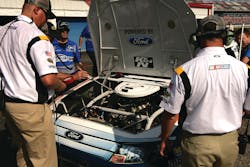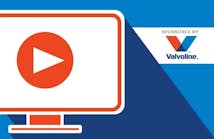Tools in the Pits
NASCAR is in the middle of the season for the 2012 Sprint Cup Series, so Big Time Boxes is taking a break so we can look at some of the important tools in NASCAR. Big Time Boxes will be back next month.
This is the first year NASCAR Sprint Cup cars are equipped with electronic fuel injection. It has a throttle body, 8 injectors mounted in the intake manifold, and all the same sensors found on any street engine, including oxygen sensors for fuel trim. As with carburetors, NASCAR regulates throttle body bore size to limit engine power at certain race tracks (remember restrictor plates?). But with this system it’s be easy to create a ‘calibrated’ intake leak that allows a higher fuel flow and therefore more power. So during tech inspection, the engine is started and NASCAR Inspectors check for vacuum leaks using the electronic listening device you would use. They also use a gauge to check fuel pressure and a special ‘scan tool’ to see the control unit’s data stream.
When the pit crew goes over the wall in a NASCAR race, two men are carrying impact guns. What most people don’t know is they all use the same tool, the Thundergun made by Ingersoll Rand. It’s the same basic design from the 1950s, but this is not your grandfather’s air wrench. The pit crews use this tool because it works better than anything else, and in this sport, they’ve tried them all. The Thundergun works best partly because it’s simple and so reliable, but also because it can be modified to perform as fast as a man can work. So just as racing engines bear little resemblance to street engines, these tools are very different from the impact wrench in your toolbox. Want to know more about the racing version of the Thundergun? Go to our Website and read the article about Jimmy Hurd.



